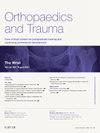Diabetes and obesity in orthopaedic patients
Q4 Medicine
引用次数: 0
Abstract
Diabetes and obesity are becoming more prevalent globally. The burden of these diseases on modern healthcare systems is projected to rise. Diabetes has multiple effects on the trauma workload, with patients being more likely to sustain injuries and exhibit a disordered physiological response. When these patients require surgical intervention, they face a higher risk of postoperative infection and mortality. Hyperglycaemia, even without pre-existing diabetes, is associated with worse trauma and surgical outcomes, including increased mortality. Authors therefore advocate for aggressive blood glucose control both preoperatively and postoperatively. There is an elevated risk of complications for patients with shoulder and elbow conditions, but not for those with wrist and hand conditions. Patients undergoing spinal, hip, knee, and especially foot and ankle procedures have a greater risk of prolonged surgical time, non-union, infection, and amputation. Medical interventions aimed at managing obesity appear to reduce the risk of complications, and certain medications are thought to influence bone healing. Bariatric surgery is advantageous, but the timing of orthopaedic surgery must be carefully planned to minimize risks. Research into the impact of diabetes and obesity in orthopaedics is expanding as the anticipated costs associated with managing diabetic patients have increased the pressure on healthcare systems.
骨科患者的糖尿病和肥胖
糖尿病和肥胖症在全球变得越来越普遍。预计这些疾病给现代卫生保健系统带来的负担将会增加。糖尿病对创伤负荷有多重影响,患者更容易遭受伤害,并表现出紊乱的生理反应。当这些患者需要手术干预时,他们面临着更高的术后感染和死亡风险。高血糖,即使没有先前存在的糖尿病,也与更严重的创伤和手术结果相关,包括死亡率增加。因此,作者提倡术前和术后积极控制血糖。肩关节和肘关节有并发症的风险增加,但腕部和手部没有并发症。接受脊柱、髋关节、膝关节,特别是足部和踝关节手术的患者有更大的手术时间延长、不愈合、感染和截肢的风险。旨在控制肥胖的医疗干预似乎可以降低并发症的风险,某些药物被认为可以影响骨愈合。减肥手术是有利的,但骨科手术的时机必须仔细计划,以尽量减少风险。随着与糖尿病患者管理相关的预期成本增加了医疗保健系统的压力,对糖尿病和肥胖对骨科影响的研究正在扩大。
本文章由计算机程序翻译,如有差异,请以英文原文为准。
求助全文
约1分钟内获得全文
求助全文
来源期刊

Orthopaedics and Trauma
Medicine-Orthopedics and Sports Medicine
CiteScore
1.00
自引率
0.00%
发文量
57
期刊介绍:
Orthopaedics and Trauma presents a unique collection of International review articles summarizing the current state of knowledge and research in orthopaedics. Each issue focuses on a specific topic, discussed in depth in a mini-symposium; other articles cover the areas of basic science, medicine, children/adults, trauma, imaging and historical review. There is also an annotation, self-assessment questions and a second opinion section. In this way the entire postgraduate syllabus will be covered in a 4-year cycle.
 求助内容:
求助内容: 应助结果提醒方式:
应助结果提醒方式:


